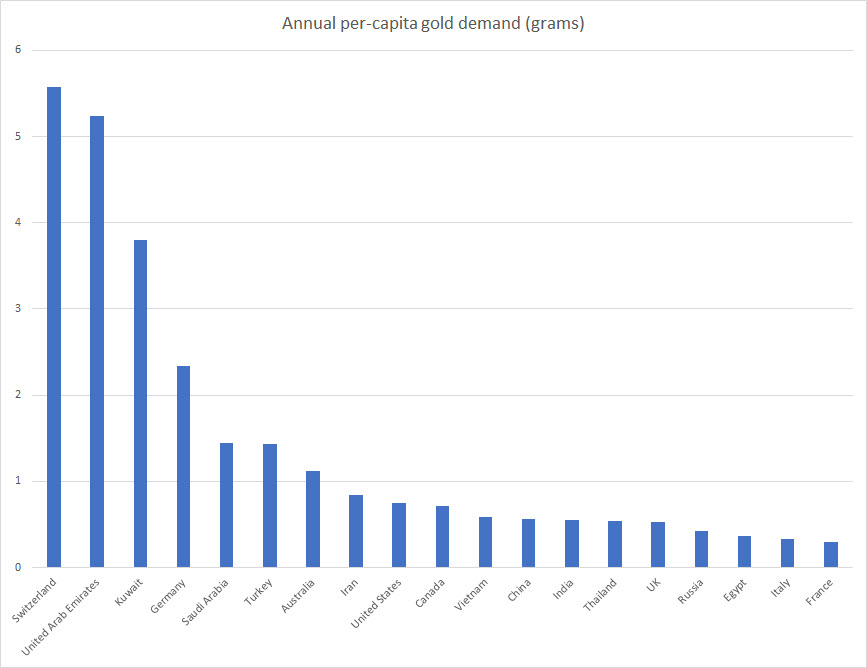Experts forecast a shaky dollar will send gold to $2,500 next year
 Bullion.Directory precious metals analysis 13 November, 2023
Bullion.Directory precious metals analysis 13 November, 2023
By Peter Reagan
Financial Market Strategist at Birch Gold Group
This is actually very moderate, as the same forecast anticipates a 200-basis-point cut to interest rates within the year. If rates drop that much in 2024, investors have plenty to worry about. Not least, dropping the Effective Federal Funds Rate (EFFR) to 3.3% would put it back in “easy money” territory – effectively undoing about half the work of the current hiking cycle.
The Fed’s most recent dot plot projects interest rates in the 5.5%-4.75% range throughout 2024. Then again, the Fed has an absolutely abysmal track record at anticipating their own decisions, so it’s not outside the realm of possibility…
We know without question that, at some point in the future, the Fed’s efforts to clean up their own mess will cause a recession. Which they’ll proceed to fix with rock-bottom interest rates and a tsunami of freshly-printed money…
The question is, WHY?
That is indeed the question asked after every boom and bust cycle brought to us by the Federal Reserve, and this one looks to be one for the history books even with cut severity still being up in the air. Cutting rates by such a large amount would stress the economy, worsen the federal government’s debt situation by making U.S. IOUs less appealing and obviously hammer the U.S. dollar. Needless to say, all massive tailwinds for gold.
On the other hand, IG Wealth Management’s Philip Petursson sees gold next year possibly climbing as high as $2,400. Petursson, who believes gold might be undervalued by as much as 20%, mentions the weakening of the dollar as perhaps the main driver of this upwards correction.
And how could we forget that an election is coming? Even as it’s not exactly around the corner, we’re already seeing a few analyses attempting to determine whether a Republican or Democratic candidate spells better news for gold.
In this debate, the only statistic that should really matter is that gold averages an annual return of 10.2% with a Republican sitting in the Oval Office and 11.2% with a Democrat keeping the chair warm. It’s one of those, “Heads you win, tails you don’t lose” situations.
Beyond that, it’s also worth mentioning that elections introduce volatility and uncertainty, which go hand-in-hand with gold investment.
Of course, this time around, things are a little different. We didn’t hesitate to assert that monetary policy would be the focal point of any candidate’s run, given what has transpired over the last three years. The problematic, gradual destruction of the U.S. dollar is something that most, if not all Americans can unite against.
We don’t want to make too many more predictions here just yet. But if Trump was sounding many economic alarms way back in 2016, when things seemed rosy in comparison, it might not be a stretch to expect a very favorable election year for gold.
 :
Powell hints towards more hiking amid hilariously bad U.S. economic backdrop
The price of gold has pulled back from $2,000 once again as the widespread impact of the Gaza conflict began to be questioned. Some will argue that equally, if not more so, the reason was that Fed Chair Jerome Powell hinted towards more rate hikes.
In so many words, he said that the inflation rate still isn’t as low as the Fed would like and that it might be persistent. This is the same Powell that called inflation transitory not long ago, but everybody makes mistakes! Let’s not roast him for that again.
What we would instead like to bring attention to, again, is the U.S. economy’s position as this saga unfolds. It goes without saying that, the greater one’s monetary tightening hopes are, the stronger the economy needs to be. If it isn’t that, unemployment and destitute living become the norm. From citizen to pundit, many agree we are already there.
Moody’s is now the third of the major credit rating corporations that has downgraded the U.S. federal government’s credit rating. This one, in particular, comes off particularly harsh in its message. We went from “stable” to “negative”. Think about that for a moment: the world’s largest economy and only superpower is no longer considered stable enough for a loan.
Specifically, Moody’s said: “with higher interest rates and without effective fiscal policy measures to reduce government spending or increase revenues,” deficits would remain large and weaken the country’s debt affordability. Furthermore, that “continued political polarization” in Congress raises the specter of debt default as well as reduces the confidence of potential creditors.
Would you loan money to a large, squabbling family who publicly argued over whether or not they intended to pay you back?
The downgrade could merely be a testament to numbers, as anyone can tell you. The deficit is jumping by the trillion, the U.S. debt even more so, and there are no solutions in sight. Whatever you might be told, there is only one solution on the table, and only one that is ever going to be applied. That is, of course, to print more money.
“Any type of significant policy response that we might be able to see to this declining fiscal strength probably wouldn’t happen until 2025 because of the reality of the political calendar next year,” William Foster, a senior vice president at Moody’s, told Reuters.
So from 2025 and onwards, we might see a return to normal fiscal policy? It’s just the election year that’s holding things up? We have to wonder what rationale Foster is using to make this statement. Does anyone truly expect the deficit to shrink, the debt to be paid off in any amount, the interest payments lowered? All of these things have been a one-way street for decades.
If the Federal Reserve and the Treasury magically conjure a way out of what looks like guaranteed economic collapse and Modern Monetary Theory: The Simulation, we’ll be the first to heap praise. But don’t expect it to happen.
After trillions of dollars being printed in a year, you’re now hearing that the M2 supply is seeing the most significant crunch in 90 years. That’s right, folks: a liquidity crunch on the heels of a historic liquidity pump.
Maintaining the U.S. dollar is going to become increasingly untenable. That much looks clear. And the moment the U.S. dollar weakens, gold investors are going to understand why the metal has been undervalued in the U.S. for a very long time. After all, if you are a Japanese gold investor with no forex exposure, you are not waiting for gold to break out of any level or price range. The fireworks have been ringing loud for some time now.
Kuwait’s investors and consumers are increasing their gold holdings
There are 196 nations in the world, according to the most politically correct counting. And it feels like gold wants an important chapter in each of those by the end of this bull cycle.
Indeed, by the end of the decade, we will most likely be able to type “country name: gold” in the search engines and have a plethora of news stories to satisfy.
It might seem like a stretch right now, especially given the turmoil in quite a few of these nations. But is it really? Russia and its many adjacent nations, Turkey, Japan, Poland, Hungary, Zimbabwe, Egypt… These are just some far-apart examples of nations with bombastic gold stories in recent times.
Kuwait’s latest update isn’t necessarily on the level of, say, Russia and Turkey. But it’s an important one, especially considering the country’s size. With a population of around 4.5 million, Kuwait can be compared to Kentucky or Oregon in terms of demographic strength.
But given the chances that less residents of Kuwait are likely to have access to gold investment, the following figures are all the more pronounced.
In the first nine months of the year, residents of Kuwait bought approximately $1 billion in physical gold. This figure translates to 14.5 tons of gold, 300 kilograms higher than last year. It would be 600 kilograms, but Kuwaitis have apparently been swapping their jewelry to make room for coins and bars – in other words, it’s a 14.5 ton net increase in gold ownership.
An annual consumption of $1 billion in investment-grade gold bullion is massive, especially in a developing nation. And so this relatively tiny Middle Eastern nation joins the ranks of big gold buyers and betters. In reality, it has been on that list for some time, so it’s more accurate to say that it has only now started capturing headlines.
In case we need to point it out, Kuwait’s economy is somewhat isolated (especially from western influence), and so are its reasons for buying gold. The nation is #3 on the list of gold-buying nations we discussed a few weeks back.

Data via World Gold Council
I imagine the average Kuwaiti doesn’t think much about U.S. mortgage rates or our Bureau of Labor Statistics Consumer Price Index reports.
Which brings us back to the original question: will there, by the end of the decade, be any sovereign nation left without its own story of overwhelming appetite for gold?
Peter Reagan

Peter Reagan is a financial market strategist at Birch Gold Group, one of America’s leading precious metals dealers, specializing in providing gold IRAs and retirement-focused precious metals portfolios.
Peter’s in-depth analysis and commentary is published across major investment portals, news channels, popular US conservative websites and most frequently on Birch Gold Group’s own website.
This article was originally published here










 Material provided on the Bullion.Directory website is strictly for informational purposes only. The content is developed from sources believed to be providing accurate information. No information on this website is intended as investment, tax or legal advice and must not be relied upon as such. Please consult legal or tax professionals for specific information regarding your individual situation. Precious metals carry risk and investors requiring advice should always consult a properly qualified advisor. Bullion.Directory, it's staff or affiliates do not accept any liability for loss, damages, or loss of profit resulting from readers investment decisions.
Material provided on the Bullion.Directory website is strictly for informational purposes only. The content is developed from sources believed to be providing accurate information. No information on this website is intended as investment, tax or legal advice and must not be relied upon as such. Please consult legal or tax professionals for specific information regarding your individual situation. Precious metals carry risk and investors requiring advice should always consult a properly qualified advisor. Bullion.Directory, it's staff or affiliates do not accept any liability for loss, damages, or loss of profit resulting from readers investment decisions.

Leave a Reply